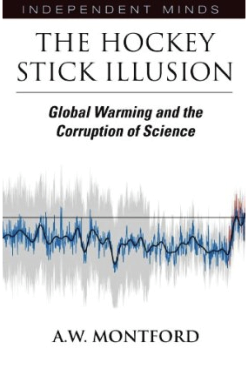The Hockey Stick Illusion - Global warming and the corruption of science
A W Montford
Published by: Stacey International
Publication date: 2010
ISBN: 978-1-906768-35-5
List price: £10.99
482 pp
www.stacey-international.co.uk

In 1998 a graph, which was to become famous as the ‘Hockey Stick’, made its debut in the pages of the prestigious journal Nature. The graph, constructed by climate scientist Michael Mann and colleagues, purported to show that late 20th Century temperatures were unprecedented in at least 1000 years. For many this was the smoking gun of Anthropogenic Global Warming (AGW). Before long the Hockey Stick became the icon of the International Panel on Climate Change (IPCC) and took (unacknowledged) centre-stage in Al Gore’s film
An Inconvenient Truth. The scientific community immediately, and virtually unanimously, accepted the Hockey Stick at face value, even though it eliminated such familiar episodes of climatic history as the Medieval Warm Period and the Little Ice Age; these were explained away as regional or diachronous phenomena.
Not everybody, though, was prepared to take this new climate history on trust. Foremost among these sceptics was a Canadian mining engineer, Steve McIntyre. Over several years, in the teeth of resistance from the paleoclimatological community, he laboriously collected the raw data (mainly tree ring measurements) from which the Hockey Stick was derived. McIntyre identified numerous shortcomings with the reconstruction. The charges included cherry picking of data, use of invalid proxies and poor statistical techniques, which together produced a picture of exceptional 20th Century warming that was not present in the underlying data.
The response of the ‘Hockey Team’ (as Mann and colleagues came to be known) was to circle the wagons. McIntyre was dismissed as a crank, or a flunkey of the oil companies. Attempts were made to prevent publication of his analyses in the scientific press. When these tactics failed to silence him, the Hockey Team claimed that many independent studies confirmed their results. McIntyre, though, was able to show that these ‘independent’ studies used the same flawed data sets and techniques as the Hockey Stick and inevitably reached the same erroneous conclusions. The debate eventually reached Washington where two congressional committees concluded that Mann’s statistics could not support the conclusions he drew from them. Nonetheless the Hockey Team, with the support of the IPCC, pressed ahead with their depiction of the Hockey Stick as ‘settled science’.
Andrew Montford tells this detective story in exhilarating style. He has assembled an impressive case that the consensus view on recent climate history started as poor science and was corrupted when climate scientists became embroiled in IPCC politics. His portrayal of the palaeoclimatology community is devastating; they are revealed as amateurish, secretive, evasive and belligerent. But the most serious charge is that they have simply failed to demonstrate any scientific integrity in confronting McIntyre. The University of East Anglia emails, which appeared just as Montford was completing his book, suggest that the Hockey Team were more interested in knobbling McIntyre than in addressing his arguments.
The wider scientific community does not escape criticism. No serious effort was made to subject the Hockey Stick to independent scrutiny, despite its profound implications for the future of the planet and its inhabitants. In response to external challenge the scientific establishment’s reflex action was to side with the paleoclimatologists without bothering to check the evidence. This approach, no better than that of any other vested interest group, should dismay everyone of genuine scientific spirit.
Montford’s book ends on what is perhaps an inevitable low note, because the Hockey Team has not conceded that its temperature reconstructions are seriously flawed. However, if The Hockey Stick Illusion provokes a truly independent review of the evidence it will have served its purpose.
Joe Brannan
Den Haag